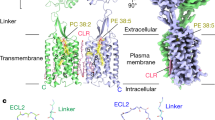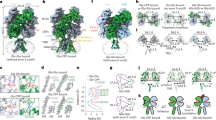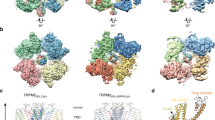Abstract
Protein movements underlying ligand-gated ion channel activation are poorly understood. Here we used disulfide bond trapping to examine the proximity and mobility of cysteines substituted for aligned GABAA receptor α1 and β1 M2 segment channel-lining residues in resting and activated receptors. With or without GABA, disulfide bonds formed at α1N275C/β1E270C (20′) and α1S272C/β1H267C (17′), near the extracellular end, suggesting that this end is more mobile and/or flexible than the rest of the segment. Near the middle of M2, at α1T261C/β1T256C (6′), a disulfide bond formed only in the presence of GABA and locked the channels open. Channel activation must involve an asymmetric rotation of two adjacent subunits toward each other. This would move aligned engineered cysteines on different subunits into proximity and allow disulfide bond formation without blocking conduction. Asymmetric rotation of M2 segments is probably a common gating mechanism in other ligand-gated ion channels.
This is a preview of subscription content, access via your institution
Access options
Subscribe to this journal
Receive 12 print issues and online access
$209.00 per year
only $17.42 per issue
Buy this article
- Purchase on Springer Link
- Instant access to full article PDF
Prices may be subject to local taxes which are calculated during checkout





Similar content being viewed by others
References
Macdonald, R. L. & Olsen, R. W. GABAA receptor channels. Annu. Rev. Neurosci. 17, 569–602 (1994).
Karlin, A. & Akabas, M. H. Toward a structural basis for the function of nicotinic acetylcholine receptors and their cousins. Neuron 15, 1231–1244 (1995).
Rabow, L. E., Russek, S. J. & Farb, D. H. From ion currents to genomic analysis: recent advances in GABAA receptor research. Synapse 21, 189–274 (1995).
Gage, P. W. Signal transmission in ligand-gated receptors. Immunol. Cell Biol. 76, 436–440 (1998).
Sieghart, W. et al. Structure and subunit composition of GABA(A) receptors. Neurochem. Int. 34, 379–385 (1999).
Krasowski, M. D. & Harrison, N. L. General anaesthetic actions on ligand-gated ion channels. Cell Mol. Life Sci. 55, 1278–1303 (1999).
Tretter, V., Ehya, N., Fuchs, K. & Sieghart, W. Stoichiometry and assembly of a recombinant GABAA receptor subtype. J. Neurosci. 17, 2728–2737 (1997).
Horenstein, J. & Akabas, M. H. Location of a high affinity Zn2+ binding site in the channel of α1β1 gamma-aminobutyric acid A receptors. Mol. Pharmacol. 53, 870–877 (1998).
Chang, Y., Wang, R., Barot, S. & Weiss, D. S. Stoichiometry of a recombinant GABAA receptor. J. Neurosci. 16, 5415–5424 (1996).
Farrar, S. J., Whiting, P. J., Bonnert, T. P. & McKernan, R. M. Stoichiometry of a ligand-gated ion channel determined by fluorescence energy transfer. J. Biol. Chem. 274, 10100–10104 (1999).
Xu, M. & Akabas, M. H. Identification of channel-lining residues in the M2 membrane-spanning segment of the GABAA receptor alpha1 subunit. J. Gen. Physiol. 107, 195–205 (1996).
Imoto, K. et al. Rings of negatively charged amino acids determine the acetylcholine receptor channel conductance. Nature 335, 645–648 (1988).
Charnet, P. et al. An open-channel blocker interacts with adjacent turns of alpha-helices in the nicotinic acetylcholine receptor. Neuron 2, 87–95 (1990).
Unwin, N. Nicotinic acetylcholine receptor at 9 Å resolution. J. Mol. Biol. 229, 1101–1124 (1993).
White, B. H. & Cohen, J. B. Agonist-induced changes in the structure of the acetylcholine receptor M2 regions revealed by photoincorporation of an uncharged nicotinic noncompetitive antagonist. J. Biol. Chem. 267, 15770–15783 (1992).
Unwin, N. Acetylcholine receptor channel imaged in the open state. Nature 373, 37–43 (1995).
Careaga, C. L. & Falke, J. J. Thermal motions of surface alpha-helices in the d-galactose chemosensory receptor. Detection by disulfide trapping. J. Mol. Biol. 226, 1219–1235 (1992).
Yu, H., Kono, M., McKee, T. D. & Oprian, D. D. A general method for mapping tertiary contacts between amino acid residues in membrane-embedded proteins. Biochemistry 34, 14963–14969 (1995).
Wu, J. & Kaback, H. R. A general method for determining helix packing in membrane proteins in situ: helices I and II are close to helix VII in the lactose permease of Escherichia coli. Proc. Natl. Acad. Sci. USA 93, 14498–14502 (1996).
Krovetz, H. S., VanDongen, H. M. & VanDongen, A. M. Atomic distance estimates from disulfides and high-affinity metal-binding sites in a K+ channel pore. Biophys. J. 72, 117–126 (1997).
Amato, A., Connolly, C. N., Moss, S. J. & Smart, T. G. Modulation of neuronal and recombinant GABAA receptors by redox reagents. J. Physiol. (Lond.) 517, 35–50 (1999).
Pan, Z., Zhang, X. & Lipton, S. A. Redox modulation of recombinant human GABA(A) receptors. Neuroscience 98, 333–338 (2000).
Hamilton, S. L., McLaughlin, M. & Karlin, A. Formation of disulfide-linked oligomers of acetylcholine receptor in membrane from Torpedo electric tissue. Biochemistry 18, 155–163 (1979).
Xu, M., Covey, D. F. & Akabas, M. H. Interaction of picrotoxin with GABAA receptor channel-lining residues probed in cysteine mutants. Biophys. J. 69, 1858–1867 (1995).
Gurley, D., Amin, J., Ross, P. C., Weiss, D. S. & White, G. Point mutations in the M2 region of the alpha, beta, or gamma subunit of the GABAA channel that abolish block by picrotoxin. Receptors Channels 3, 13–20 (1995).
Twyman, R. E., Green, R. M. & MacDonald, R. L. Kinetics of open channel block by penicillin of single GABAA receptor channels from mouse spinal cord neurones in culture. J. Physiol. (Lond.) 445, 97–127 (1992).
Wooltorton, J. R., McDonald, B. J., Moss, S. J. & Smart, T. G. Identification of a Zn2+ binding site on the murine GABAA receptor complex: dependence on the second transmembrane domain of beta subunits. J. Physiol. (Lond.) 505, 633–640 (1997).
Sigel, E., Baur, R., Trube, G., Mohler, H. & Malherbe, P. The effect of subunit composition of rat brain GABAA receptors on channel function. Neuron 5, 703–711 (1990).
Connolly, C. N., Krishek, B. J., McDonald, B. J., Smart, T. G. & Moss, S. J. Assembly and cell surface expression of heteromeric and homomeric gamma- aminobutyric acid type A receptors. J. Biol. Chem. 271, 89–96 (1996).
Sigel, E., Baur, R., Kellenberger, S. & Malherbe, P. Point mutations affecting antagonist affinity and agonist dependent gating of GABAA receptor channels. EMBO J. 11, 2017–2023 (1992).
Amin, J. & Weiss, D. S. GABAA receptor needs two homologous domains of the beta-subunit for activation by GABA but not by pentobarbital. Nature 366, 565–569 (1993).
Smith, G. B. & Olsen, R. W. Identification of a [3H]muscimol photoaffinity substrate in the bovine gamma-aminobutyric acidA receptor alpha subunit. J. Biol. Chem. 269, 20380–20387 (1994).
Boileau, A. J., Evers, A. R., Davis, A. F. & Czajkowski, C. Mapping the agonist binding site of the GABAA receptor: evidence for a beta-strand. J. Neurosci. 19, 4847–4854 (1999).
Wilson, G. G. & Karlin, A. The location of the gate in the acetylcholine receptor channel. Neuron 20, 1269–1281 (1998).
Higaki, J. H., Fletterick, R. J. & Craik, C. S. Engineered metalloregulation in enzymes. Trends Biochem. Sci. 17, 100–104 (1992).
England, P. M., Zhang, Y., Dougherty, D. A. & Lester, H. A. Backbone mutations in transmembrane domains of a ligand-gated ion channel: implications for the mechanism of gating. Cell 96, 89–98 (1999).
Zhang, H. & Karlin, A. Contribution of the beta subunit M2 segment to the ion-conducting pathway of the acetylcholine receptor. Biochemistry 37, 7952–7964 (1998).
Acknowledgements
This work was supported in part by grants from the National Institutes of Health NS30808 (M.H.A.), GM61925 (M.H.A.) and NS34727 (C.C.), and a Burroughs Wellcome Fund New Investigator Award (C.C.). We thank A. Finkelstein for comments on this manuscript.
Author information
Authors and Affiliations
Corresponding author
Rights and permissions
About this article
Cite this article
Horenstein, J., Wagner, D., Czajkowski, C. et al. Protein mobility and GABA-induced conformational changes in GABAA receptor pore-lining M2 segment. Nat Neurosci 4, 477–485 (2001). https://doi.org/10.1038/87425
Received:
Accepted:
Issue Date:
DOI: https://doi.org/10.1038/87425
This article is cited by
-
Human pharmacology of positive GABA-A subtype-selective receptor modulators for the treatment of anxiety
Acta Pharmacologica Sinica (2019)
-
Oxidative Modification and Its Implications for the Neurodegeneration of Parkinson’s Disease
Molecular Neurobiology (2017)
-
γ-Aminobutyric acid (GABA) signalling in plants
Cellular and Molecular Life Sciences (2017)
-
Some insights into the binding mechanism of the GABAA receptor: a combined docking and MM-GBSA study
Journal of Molecular Modeling (2013)
-
Pore Structure of the Cys-loop Ligand-gated Ion Channels
Neurochemical Research (2009)



